A wildly entertaining play to get you excited about Australian theatre again
By John Shand, Michael Ruffles and Shamim Razavi
THEATRE
CUT CHILLI
The Old Fitz, July 5
Until July 27
Reviewed by KATE PRENDERGAST
★★★★★
Could Chenturan Aran’s Cut Chilli be the best new Australian play to arrive on Sydney stages this year?
In final form under David Burrowes after several years in development, this New Ghosts Theatre Company production is a wildly entertaining and terrifically sharp “meet the parents” comedy wrapped in a larger, continents-crossing story about cultural heritage, racial identity and the tangled nature of truth-telling.
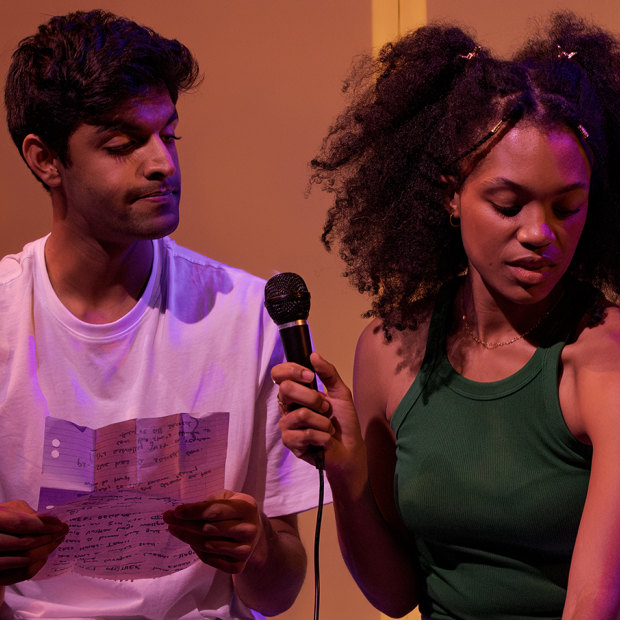
Ariyan Sharma, left, and Kelsey Jeanell in Cut Chilli.Credit: Phil Erbacher
It’s at a new Indian fusion restaurant (serving Kerala kangaroo) that protagonist Jamie (a thrillingly oddball Ariyan Sharma) tells his new, fiercely intelligent Muslim girlfriend Zahra (a radiant Kelsey Jeanell) that he was adopted. Abandoned by his birth mother in Sri Lanka, he was raised by a white family in Mandurah, Western Australia.
Sensing a story, Zahra whips out her recorder – she has a podcast called The Decolonising Diaries, and envisions a spin-off: Decolonising My Boyfriend.
Was he abandoned? Was he “saved”, as his adoptive family has told him, and he dutifully repeats? Or, as Zahra’s interrogative hunch suggests, was he stolen?
There was – and this is true – a whole industry of adoption fraud in the ’70s profiting off the white saviour complex. Clowning his way to adulthood to survive his difference, Jamie hasn’t had the confidence to claim his own story.
With a flight to Perth, Zahra beside him, the pot of history is about to be stirred.
Who could be prepared for the McKenzies, though? Not Zarah, for whom a huge rug is rolled out as a prayer mat (“hey, Google! Play the call to prayer!“). Not the audience either, who will cringe, laugh and gasp in tickled horror.
The oversensitive wine-rinsed mum (Susie Lindeman); the excitable local councillor dad (Brendan Miles); the petty crook of an uncle (Noel Hodda) – together they make a hilarious send-up of a dysfunctional white suburban family untouched by the kinds of discourse Zahra engages every day. Woke, they are not.
That doesn’t mean they don’t love their Jamie.
In striking tone shift to this riot, a voice is sometimes heard in a foreign tongue. Her words are subtitled in projection on wooden panels that fold out to make a screen. So too are dreamlike images of rippling waters, tides-smoothed stones and a woman with brown skin and dark eyes.
The blistering wit of this play, its idiosyncratic characters, and its case for compassionate dialogue – Cut Chilli makes me excited for Australian theatre. It’s a blazing standout in Old Fitz’s season.
MISSY HIGGINS
Darling Harbour Theatre, ICC, July 6
Reviewed by James Jennings
★★★★
Melbourne singer-songwriter Missy Higgins is a generous performer in more ways than one. In bang-for-your-buck terms, punters get two concerts for the price of one: an “Act 1” featuring stripped-back versions of old and brand-new songs, and an “Act 2” in which every track is played from Higgins’ debut album The Sound of White, which is celebrating its 20th anniversary this year.
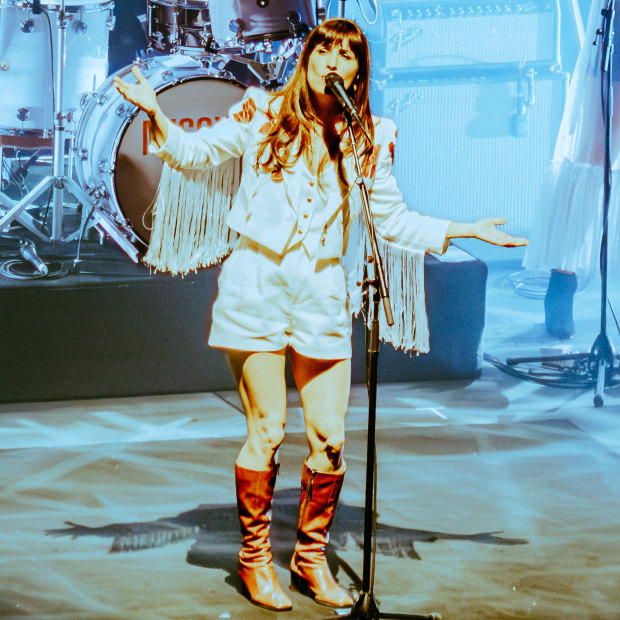
A generous performer in more ways than one: Missy Higgins.Credit: Louise Cui
From the get-go, it’s clear Higgins’ generosity also extends to how much she gives of herself on stage. Almost every song is accompanied by an engaging and wittily told story relating to its genesis, creating a live, and frequently hilarious, behind-the-scenes audio commentary.
There are plenty of self-effacing quips – Higgins apologises for potentially bringing down the celebratory mood with a maiden song that’s depressing, “which applies to about 99 per cent of my catalogue”. But there’s never a lack of joy in the room, from the audience nor from Higgins herself, who’s understandably thrilled to have 6000 people come to see her play.
That joy hits a high note when Tim Minchin makes a surprise appearance to perform Carry You, his collaborative song with Higgins.
The jokes also come with the occasional raw, heart-on-sleeve story that only deepens Higgins’ connection to the audience.
Her on-stage persona is akin to the funny, knockabout friend who often opens up and floors you with their honesty and vulnerability.
Those moments typically come when Higgins plays songs off coming album The Second Act, which she says is about a devastating break-up.
The anecdote that comes with the gorgeous Blue Velvet Dress, about Higgins performing on TV in front of millions for a 2021 Sydney New Year’s Eve concert only moments after the aforementioned split, is both vivid and heartbreaking.
It’s testament to Higgins’ prowess as a performer and storyteller that the night could’ve ended with Act 1 and no one would’ve left disappointed, but then Act 2 arrives and six musicians join Higgins on stage for an immaculate run-through of The Sound of White.
Thorny new song When Four Became Three, debuted earlier, may have warned “be careful what you love”, but after this night’s show, loving Higgins and what she refers to as her “bleeding heart” is an easy thing to do.
TRIVENI
Sydney Opera House Concert Hall, July 7
Reviewed by John Shand
★★★★½
Zakir Hussain’s hands don’t play the heads of his tabla, they dance upon them. The emergent rhythms, melodies and textures are as deep and mysterious as the music of the ancients, as sophisticated as the most complex composed music, and as innovative as tomorrow.
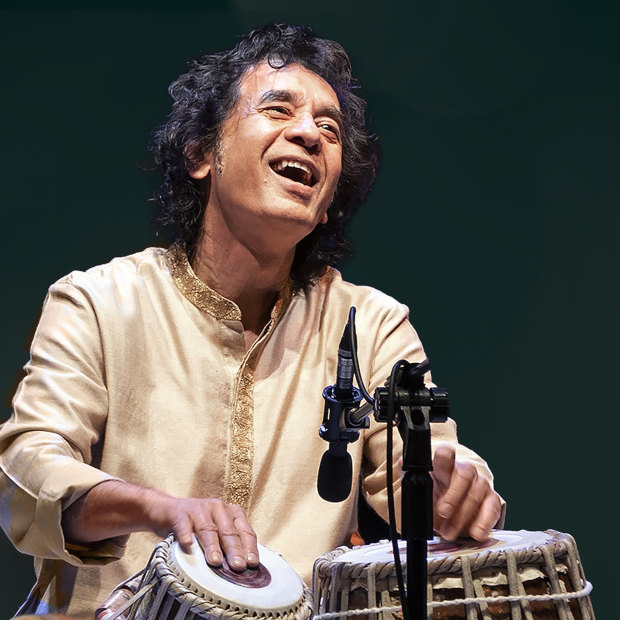
Zakir Hussain blends the two great strains of Indian classical music.Credit: Mallikarjun Katakol
No wonder he stands at the pinnacle of Indian classical music, while also being the most acclaimed tabla player in the west.
Equally reverential and forward-thinking, Hussain, like his father before him, dares to blend the two great strains of Indian classical music: Hindustani (from the north, wherein lie his own roots) and Carnatic (from the south).
Formed two years ago, Triveni features Hindustani violinist Kala Ramnath and Carnatic veena player Jayanthi Kumaresh, the name being the mythical junction of three sacred Indian rivers. Hearing the music, it could be two rivers with Hussain as the bridge spanning both.
They improvised upon Raag Charukeshi, beginning with the swoops of Ramnath’s violin, which had an opulence of tone akin to a viola, while the idiom’s love of glissandi made every note seem like an arrival or departure point.
Ramnath and Kumaresh initially passed the baton of pensive improvisation between them, until finally Hussain joined, and the sound quality was flawless as the violin cried like a grieving mother, and the veena evinced some subterranean connection to the blues.
You sensed the danger of the extraordinary hovering in the air before it exploded, just as Hussain seemed to know what his improvising colleagues would play before they did it. Now 73, he’s been performing this music for over 60 years, and is as heartfelt and intuitive as he is virtuosic.
His dialogues with the veena were more playful than those with the violin, as he mimicked Kumaresh’s glissandi, and gradually became ever more adventurous and ingenious. Yet, through all the complexity and sophistication came this childlike joy of playing games with each other – games that just happened to be musical.
Finally, Hussain soloed, beginning with figures of nursery rhyme simplicity, upon which he built and built, until you’d swear the resultant rhythmic and melodic edifice was the work of a multitude rather than merely a mortal with 10 fingers and two drums.
Here was a concert to expand and enliven the spirit; to make one feel human more intensely in a grey and often gruesome world.
DRACULA
Roslyn Packer Theatre, July 6
Until August 4
Reviewed by JOHN SHAND
★★★½
Sometimes the images are laid atop one another, like so many memories clamouring for focus in a brain. Sometimes the visual effect is wondrous, as when the characters of Holmwood, Morris and Van Helsing seem real rather than on a screen as they converse with the live Seward, echoing the unforgettable dinner party scene in The Picture of Dorian Gray.
Dracula is the third and final instalment of the gothic cine-theatre trilogy that began with Dorian Gray (2020, and now playing in London) and Strange Case of Dr Jekyll and Mr Hyde (2022), devised by Sydney Theatre Company’s departing artistic director, Kip Williams. In case you’ve been hiding in a grave in Transylvania, cine-theatre combines live video of real-time acting with pre-recorded images.
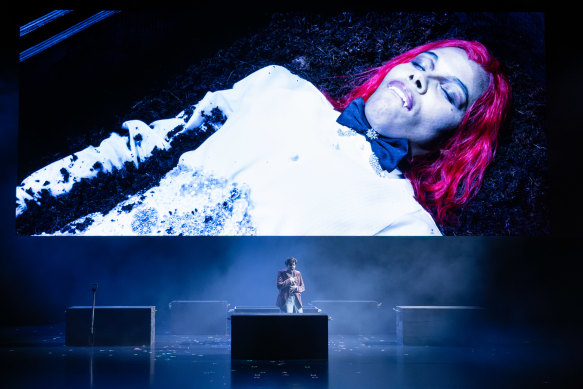
Zahra Newman takes on 23 roles in Sydney Theatre Company’s adaptation of Dracula.Credit: Daniel Boud
Playing all 23 roles is the gifted Zahra Newman. The characters may appear exclusively on screen, or be defined by wig and costume changes made before our eyes. Yet, as good as Newman is, especially in her vocal variation, Dracula doesn’t work as well as its predecessors. Firstly, it’s simply not scary enough. For all the B-grade movies it has engendered, Bram Stoker’s 1897 novel is genuinely unsettling, whereas when Williams’s rendition reaches for gothic horror, the audience laughs.
Given the constant presence of extraordinarily diverse music (written or selected by Clemence Williams) it’s possible Williams’ intention was to satirise hyperbolic melodrama. That would seem odd, however, when he was previously so keenly attuned to serving the intentions of Oscar Wilde in Dorian Gray and Robert Louis Stevenson in Jekyll and Hyde. Stoker may be a lesser writer, but if one seriously wanted to lampoon his work, it could be much funnier than this.
The cemetery scene is certainly creepy with its confusion of crosses, and Newman looks startling enough when she’s playing the titular character in a cerise wig. But one might have hoped for at least one moment when you were inclined to grab the person next to you, if not run screaming from the room.
Put the scariness issue to one side, and the mechanics of the story telling aren’t as sound as Williams’ previous efforts. In adapting what is an epistolary novel, some characters, especially Jonathan Harker, Seward, Morris and Holmwood, become a little blurry, like the men who aren’t Macbeth in Macbeth – contrasting with Newman’s utterly distinctive creations of Renfield and Van Helsing.
A deeper issue is seemingly embedded in the idiom’s dazzling virtuosity. One of Williams’ major innovations in Dorian Gray – moving the screens upon which the images are projected, whether up and down, or tracking them horizontally or towards and away from us – exploded the idiom’s potential to amaze us, while conjuring the characters’ internal worlds. (The latter aspect is crucial here because, via their diaries and letters, we’re constantly scrutinising the characters’ perceptions, which may be less than reliable.)
Yet this visual and performative virtuosity, like wanton virtuosity in music, breeds a sort of greed in the audience. Having been astounded, if we’re not astounded even more, we’re disappointed. It’s interesting that amid this technological extravaganza, an abiding memory will actually be Newman’s voice – always a sumptuous instrument – and the way it delineates character with much more clarity than the costume and wig changes.
The core of the design team (Williams, Marg Horwell and Nick Schlieper) remains intact, and the new members are phenomenally expert. Twelve technicians shadow Newman on stage, and Williams accelerates and mutates the ending – by which time it was starting to lose me.
Sydney Symphony Orchestra
Sydney Opera House Concert Hall, July 5
Reviewed by HARRIET CUNNINGHAM
★★★★½
Dalia Stasevska is quite something. Ukrainian-born, Finland-bred and increasingly in demand internationally, she has made an auspicious debut with Sydney Symphony Orchestra conducting three generations of Finnish music.
Rautavaara’s Cantus Arcticus, was an ideal place to start: a wandering song from the orchestra’s principal flutes to focus the ears, before the sonic surprise of recorded birdsong floating into the mix: real sound layered with real but different sound, and all with beautiful clarity. Then more layers in the final movement, Swans Migrating, where the chatter of birds mixed with aleatoric figures in the wind to make an almost chaotic, bell-like jangle of reverberations, over which cellos and brass mapped out wide, open skies. Stasevska carved the epic, warm ensemble sound like a sculptor.
Trans, Concerto for Harp and Orchestra, by Kaija Saariaho, took us into another set of layers: the intricate, cut-through lines of harp translated and transformed against other timbres from throughout the orchestra. The second movement explored melting, bending and decaying sounds, while the third movement, Messager, was powered by a spooky ostinato underpinning melodic codes and puzzles. Stasevska led the orchestra through this tricksy maze with assurance.
Harp virtuoso Xavier de Maistre, for whom the work was commissioned, was a riveting technician of sound and gesture. Then, from sonic explorer to ebullient show-off, he rewarded the audience with sparkling encore of Felix Godefroid’s Carnival of Venice.
After the interval Stasevska turned to face the audience to introduce the music about to unfold and, if it wasn’t already clear from the previous works, her passion for Finnish music shone through. In particular, she spoke of the six final chords of Sibelius’ Fifth Symphony and, more importantly, the magic of the silences between these chords.
Was it this that drove her decision to roll from the comforting rhythm of the slow movement to the hurly-burly of the last, attacca, knitting together the dense and muddy textures, so that the silences landed like shafts of light? Whatever the reason, the cumulative effect was a spectacular end to an exceptional performance.
GENESIS OWUSU
The Tank, Art Gallery of NSW
Volume Festival, July 5
Reviewed by MICHAEL RUFFLES
★★★
The idea was too good to be perfect. One of the country’s boldest and most interesting alternative/R&B/hip-hop stars, a man who invokes Kafka and cockroaches and thrives in dark places, descended into the bowels of a subterranean World War II fuel bunker for a headline turn at a music festival.
Only problem is, as Genesis Owusu discovered when he first visited the Tank at the Art Gallery of NSW, you can clap your hands and hear the echo minutes later. The cavernous space and its 125 pillars required the ARIA winner to take a different approach to each of the songs he had otherwise finely honed after a six-country tour.
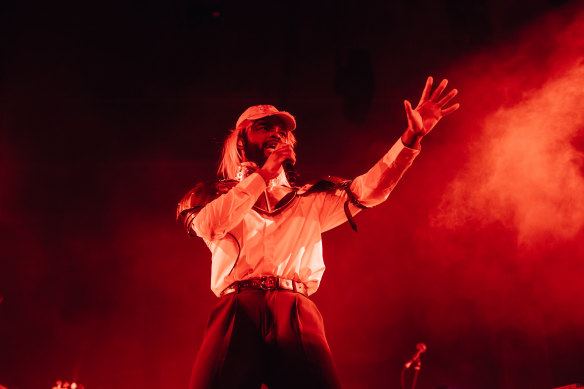
Genesis Owusu’s show included drum machines, fiddles and throat singers.Credit: Jordan Munns
Owusu’s “night of experimentation and improvisation” included drum machines, fiddles and throat singers. He kept his back to us for the first five minutes while the guttural, almost menacing introduction reverberated.
The first song proper, Leaving the Light, is an anthem of defiance from the point of view of a pest escaping a vengeful god, and it crackled through the space as Owusu stood imperious in his armour. If he was not lord of this underworld, he was one of its furies.
Survivor, however, came across somewhat subdued compared with its studio version, despite the staccato machine-gun beats; for the plaintive Old Man, Owusu’s voice soared but he’d positioned himself so that few could see him.
The Ghanaian-Australian rapper and singer from Canberra occasionally let a kookaburra-like cry loose, and had clearly given a lot of thought about how best to exploit an area better suited to an art installation. Walking through the crowd helped, and pleasingly the slower jams came to the fore. Gold Chains and A Song About Fishing worked well, while bangers Tied Up! and Balthazar struggled.
The amusingly bitter Don’t Need You faltered under the weight of the reverberating bass, but the show ended on a high if abrupt note with the rousing Stay Blessed.
Both the performer and the space are impressive, and it is exciting to think about what they’ll each do next. But on the first date, they did not seem a perfect match.
HOCKEY DAD
Hordern Pavilion, July 7
Reviewed by SHAMIM RAZAVI
★★★★
Hockey Dad have a keen sense of history. It comes across in drummer and co-frontman Billy Fleming’s reflection that it wasn’t so long ago he was at the Hordern watching his own heroes. It also comes across in their respect for the bands –Iggy Pop, the Cure, Pavement, Arctic Monkeys – that influence but never overwhelm their art. Those musical references offer Easter eggs for the musos in the crowd but more importantly locate and enrich the sound that bathes an audience deep in party mode.
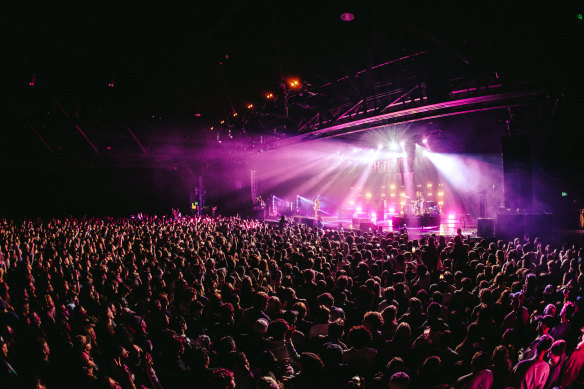
Hockey Dad know their fans well – and don’t let them down.Credit: Jordan Munns
It is a sound distinctly their own, distinctly Australian. Harking from down the road in Windang, the band’s lyrics translate that musical heritage into sentiments both direct and modern. Maybe it is the proximity in time and geography that separates us from them that makes the relationship between this band and its audience so thrillingly close.
No need to ask what this crowd have been listening to in the three weeks since the band’s new album dropped: in a set that opens with Base Camp from that record and features six more of its songs, the audience sings along with every word. And what those latest songs lack in familiarity, they make up for with a maturity that is more than a match for the old favourites.
The well-worn numbers pepper the night, drawing the show together just as things start to wander. The effect is best demonstrated on the switch from muted That’s on You – complete with acoustic guitar and poetic ramblings on dying trees and rotting leaves – to Itch, whose bell-like opening notes serve as a rallying call for anyone who had strayed to the bar. This band not only knows, but also serves, its fans.
As excellent as their new work is, they know that songs like set-closer Join the Club are unrivalled crowd pleasers, and please the crowd they do.
The overall effect is of a band on the rise, beginning to master its powers of both craft and performance. Windang’s finest may also be Australia’s.
The Booklist is a weekly newsletter for book lovers from books editor Jason Steger. Get it delivered every Friday.